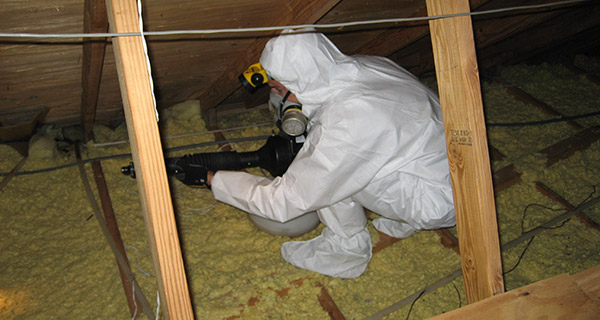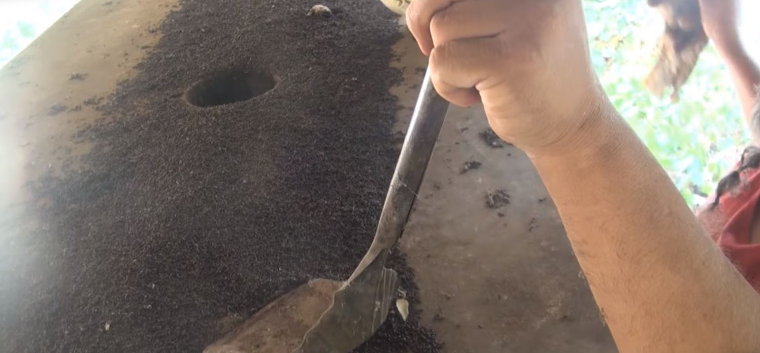-
info@aaanimalcontrol.com
Call us for help in your town
Humane Wildlife Education
How to clean up bat guano inside a building
Need bat removal in your hometown? We service over 500 USA locations! Click here to hire us in your town and check prices - updated for year 2020.
Guano, poop, droppings; whatever you want to call it, the mess that bats can leave behind can be pretty dangerous. If you thought that the bats were annoying, you haven’t seen anything until you have had to clear up after a whole colony of them!

Not only will the guano/bat droppings leave a rather nasty smell behind but they can also be dangerous to you. You are going to want to keep yourself, your children, other members of your family and even pets away from the mess that has been left behind. Inhaling the bacteria that guano can carry can cause a rather nasty infection of the lungs called histoplasmosis.
Find out: How to remove bats or rodents from barrel tile roofs
The nasty sounding condition can go relatively unnoticed for the most part and doesn’t tend to give off any symptoms in well, healthy people. However in young people and those that have a weak immune system, the damage can be incredibly dangerous. In short, keep away if you can. With symptoms such as fever, chills, headaches, discomfort of the chest and muscle aches, all combined with nasty dry coughing that be very painful, you are going to want to avoid this at all costs.
Learn more: What if you are bitten by a bat
Of course, the bacteria that can cause disease is probably the last thing on your mind once you have had a team of experts come in and remove your bat problem. The droppings left behind can cause quite the eye-sore, and on top of that, if left there to rot, will smell pretty nasty after just a day or two, especially in warmer weather. That’s before you even begin to think about the other insects, such as cockroaches, that are attracted by the scent of the bat poop left behind. Oh and a final piece of bad news for you – the poop left there can also attract other colonies, which is why you are going to want to hire a team of experts, or an expert to remove the bat problem – if it is not done properly, the inhabitation will never fully go away.
Once you have successfully removed the bats from your property and sealed all the exit and entrance points that you can see that they were using, you are going to want to get rid of the droppings. You are going to need a few things to hand:
- Full plastic body suit, even covering feet
- A face mask
- Safety goggles
- Thick and strong rubber gloves
- A strong enzyme-based cleaner
- A large industrial vacuum, designed for such as task

See – this is why you should hire a professional. There is a lot of work to do just to remove the bat droppings. The first step is to actually remove the droppings from the surfaces of your home. This could mean the ceiling, the walls, any tables and surfaces that have become exposed the bats, and even the floor and the outside of your home. A strong, industrial sized vacuum cleaner can often handle this task well, and will usually have a smaller filter/head that will be used to vacuum up all of the remnants once this initial scraping and vacuuming task has been complete, and a strong cleaner has been used to kill any bacteria and also to remove the staining that the bat droppings will always leave behind. You may even find that you will want to repaint your surfaces and walls afterwards – the droppings are very messy and WILL stain.
One thing that you should always remember is that you should never try to attempt to clean the guano when the bats are still living in your home. Firstly, they will continue to make a mess the whole time that they are living there and secondly, it is actually illegal to harm the bats – something that the cleaners and vacuum cleaners probably will do. In short, it’s always advisable to hire a guy to do the job properly!
How to get rid of bats
How to remove bat feces from concrete
Need wildlife removal in your hometown? We service over 500 USA locations! Click here to hire us in your town and check prices - updated for year 2020.One of the vital parts of the process of bat removal is making sure that you have removed all material that could have been contaminated by the animal(s) or left by the animal(s). If you have had a large colony of bats living in your home, there's a very good chance that this will mean a rather large pile of bat droppings, also known as guano, left behind. You can expect more animals to create more droppings, but bats have a very fast metabolism and they also eat an awful lot of insects. Together, this makes quite the guano problem.

As well as smelling bad, bat guano is also rather dangerous. Again, the more poop you have, the bigger the problem, both in terms of smell and disease. With larger piles of poop, it might even be the odor that alerted you to the bat problem in the first place. This is often the case with many home and property owners, especially those that do not regularly check the upper levels of their home, such as the attic.
Bat guano or droppings can contain the spores of a disease called Histoplasmosis, and this is not a pleasant disease to invite right into your home. That's essentially what you will be doing if you leave the bat droppings behind, or you make sure that you haven't done a good enough cleaning-up job.
The Histoplasmosis disease is actually caused by a fungus, and this goes by the name of Histoplasma. Wherever you find either bat or bird droppings, you will probably find Histoplasma, although there are certain areas across the United States that are known to be worse than others. The Mississippi River Valleys has historically been known to be a hard-hit area, as has Ohio and other places across eastern and central USA.
Now that we have established that bat feces is incredibly dangerous, we hope that you now understand the importance o the appropriate safety gear for a task like this. You WILL need a breathing mask. Histoplasma can be sent into the air like dust when it bad poop has dried. We do not recommend sweeping up bat feces, but instead using a vacuum filter. If you do not have one of these, you will find that most wild animal removal specialists that work with bats will have something similar that they can use to help you safely complete the cleanup operation.
You will also need strong biological cleaners to make sure that you have erased all biological traces of the bats ever being in your building. You will often find that you will need stronger stuff than the kind of thing that you can easily buy over-the-counter. Once again, a wildlife removal expert that has knowledge in, or is an expert in the field of bats will have all of the necessary equipment to get this job done.
Even a modest pile of bat guano can spread disease, give off a foul odor, and create further health hazards if it is not dealt with, and the corrosive nature of the guano also means that it will soon start to wear through any materials that it has come into contact with. If you have a large bat colony up in your attic that has managed to go undetected for a period of time, the pile of guano could build up to a point where the corrosive action burns through wooden foundations and potentially even ceilings.
How to remove bat feces from concrete
You must first make sure that you have used exclusion devices to get rid of the bats from your building, as well as sealing up the smaller and lesser-used entrances, before finally sealing up the final hole(s) when you are 100% sure they're all gone. If you don't do this, your cleanup operation will have been in vain. The bats will just come right back, build up colony numbers again, and you'll be right back to where you started, and with even more (probably expensive) problems on your hands.
You cannot sweep up bat guano because of that disease-inhalation-risk, so this means that you must use a filter vacuum to make sure all traces of the guano has been removed. Only then can you start the scrubbing action, and you're going to want to make sure you keep the protective gear on throughout this part of the journey too. The breathing mask will come in handy when you're using strong chemicals and mixes of chemicals to rid the area of odors and biological or contaminated material.
Once a strong biological enzyme cleaner has been used over the entire area, even going as far as to clean areas just outside of the obvious contamination zone, you will then need to look at cleaning the area one more time, using an even stronger biological cleaner. There are natural items that are considered to be antiseptics, disinfectants, antifungal, antibacterial, etc., and you can use these also, but only after you have let the chemicals work their magic. Sadly, as much as you don't want these strong and hazardous chemicals in your home, they are one of the only ways to remove the hazardous biological material left there. You will also find that many of the ingredients that are used in these cleaners are so strong that only registered people can use them, thus enforcing the need to call in the professionals to make sure the job is done properly.


















